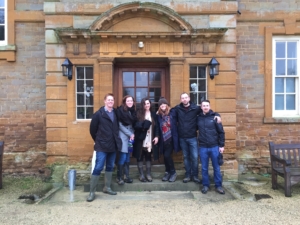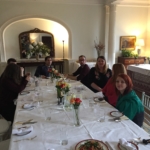As Autumn turns to Winter, many teams head into their annual planning season and the inevitable team offsite to prepare for 2018.
Hitherto unsolved problems require new thinking to crack them. This is the thinking behind the offsite; take the team to a new environment, give them some new stimulus and run them through some new exercises to come up with new solutions. With this ethos in mind we took the Spredfast EMEA Customer Success team off to Poundon House in the Oxfordshire countryside for two days of brisk walks, stiff gins and hard work.
Since I began my role we have had an offsite meeting every six months to work through process issues and to explore new ideas so that we can optimize the customer experience. Having done many of them in the agency environment I was keen to see what could be brought to the SaaS environment and how they would work. What follows is 6 things that worked.
Three things for the right context
1) Bring the right people: cross fertilize. We are fortunate in the EMEA team at Spredfast that we have representation from each part of the Customer Success process. From the on-boarding, enablement and training that the customer receives when they join Spredfast through to the Customer Partners who manage the accounts, the Strategic Servcies team who can help with the thinking and planning required to get a social program flying and the Customer Support team that is on the end of calls and email when there are usage questions; we have team members for across the full customer experience. This proved to be invaluable as we spent time at the offsite working to understand where operations could be optimized or where we wanted to kick around new ideas.
Aside for the benefit of having a plurality of voices there is another very real advantage to this in that it is possible to thoroughly test an idea. As you try to crack an issue or craft an improvement across the customer’s journey through the organization you need to understand how it’s actually going to impact different teams. Not just in theory but with specific worked examples and feedback from those who will be impacted. The law of unintended consequences is the nemesis of operational change. The corollary is ‘don’t be afraid to leave some people out’. This isn’t the company summer picnic, so just bring the people you need and happily exclude others who won’t add to the conversation around the specific issues you’re dealing with.
2) Find a comfortable location that’s a bit of a surprise. To jolt the senses into new thinking I think you want a different environment; something that’s out of the everyday. NOT a corporate hotel. But you also want to be comfortable; roaring fires, pots of tea, piles of cake and a well stocked bar are all vital to the thought processes of operational excellence. Old friends of mine own an old house. On the weekends they open it up for weddings, but during the week it’s a quiet idyll sitting in the rolling hills of Oxfordshire. It’s still pretty true to it’s origins as a country house so there are no ensuite bathrooms, dinner is what has been cooked for everyone (although some wonderful vegetarian options were made available) and once you’re tucked in around the fire you pour your own drinks and bring in your own logs. From my point of view it was exactly the right balance of informality so that he team felt comfortable combined with a bit of a grand country house to make it feel like an event. We went to Poundon, but the National Trust also has dozens of places around the country you can also dry hire (BYO catering and booze) which also brings down the costs.
3) Go for a walk. I wanted to provide a mix of mindfulness with some traditional country pursuits in a blend of new age ideals meets traditional values. Yes, it’s true I tried to get some shooting organized and yes, I also tried to get a guru who would do guided meditational yoga classes. In the end I thriftily opted for something mid-way between the two; country walks. The first day was so foggy it was like walking through a cold steam room, but the second day dawned crisp and bright and we had a very successful hour of tramping over the hills and paddocks around the house. I’m not going to go into the benefits of walking sessions here, but for a combination of exercise, conversation, brainstorm and a bit of natural history education it cannot be beaten.
“We can’t solve problems by using the same kind of thinking we used when we created them.” (Obligatory Einstein quote) and we can’t expect our teams to crack the same old problems if we don’t give them new tools. One of the things I was particularly keen to do at the offsite was to give the team some insight into the kinds of tools that are available and to have them apply them to real issues that we face every day with cusotmers.
1) Change Management
Selling in a new software product to a customer requires an element of change. At its simplest it’s a change from one product to another, but usually it’s a harbinger of some larger, more systemic change. The challenge is that sometimes your customer doesn’t realize that’s what they’re going through or if they do, haven’t got a plan of how to militate against problems arising or to mitigate them once they do.
Change management is a well established field of management theory so there’s no shortage of reference materials to draw on. The management consultancy McKinsey provides a series of white papers covering a wide range of management issues and approaches. I picked a set of articles that ranged from the fairly academic Global Survey to the more discursive interview with Chip Heath, author of ‘Switch”. These are the papers;
- The Role of Networks in Organizational Change (Cross, Parise and Webb, McKinsey Quarterly, April 2006)
- Making the emotional case for change: An interview with Chip Heath (McKinsey Quarterly 2010)
- The irrational side of change management (Aiken & Keller, McKinsey Quarterly 2009)
- Organising for Successful Change Management: A Global Survey (McKinsey Quarterly June 2006)
I distributed these amongst the group as a pre-read ensuring that members of the same teams received different papers so we’d get different perspectives.
At the actual off site we then did an exercise where as a group we looked at the issue of adoption. (Adoption in the SaaS world is the path to the Holy Grail. If customers adopt, i.e. start using the product, and assuming the product does what it’s supposed to, then you’ve got a good chance of them renewing, which in a subscription based business is obviously fairly key…). Adoption can stall or fail for all kinds of reasons, but a key one that I have observed results from a failure to manage the change from what the customer’s users were doing before to the new behavior that involves using the software.
So with our pre-reading done we worked as a group to review each stage of the customer’s journey with Spredfast and what changes needed to happen on the customer’s side at that stage to achieve adoption. With the key change challenges mapped we then used insights from the reading to develop either plans to prevent adoption issues arising beforehand or actions to remedy situations that arose in flight.
2) The Checklist Manifesto
As a time poor member of a full time working parenting team I have come to embrace systems. Meal planning, online shopping lists, shared calendars have all made what was once a chaotic existence slightly more structured and manageable. So when I was introduced to Atul Gawande’s “Checklist Manifesto”, I was an easy convert and have since regularly given it to teams that I have worked with. The Spredfast team was no exception and in December I duly gave each member of the Customer Success team a Xmas stocking filler copy of Manifesto.
To precis the book, Gupte is a medical doctor who looked at other professions (aeronautics, construction, investment banking) who dealt with a similar number of variables but were achieving greater consistency of results and found that checklists were the common factor.
The exercise at the offsite was for the group to break up into functional teams and develop a checklist for a regularly occurring event within their operational process. There were two quite different responses. One was what I had expected, the team developed a checklist for something they did regularly; the Customer Support team developed a checklist for a regularly a required diagnostic. What I hadn’t expected was teams developing checklists to hand to other teams to manage their delivery; the Enablement team developed a checklist for the Sales team to ensure that everything they needed from the customer was gathered and documented.
Don’t be surprised if there is resistance to this process, especially if you have quite highly skilled professionals in your teams. Their response could well be ‘I don’t need a checklist! I perform this procedure twenty times a week.’ Gupta makes the point however that this is not about capturing things that are not usually done, it’s about capturing all the things that need to be done and making sure that they actually are. Apparently it’s often the most commonly performed tasks that get skipped, because we’re not consciously checking them off.
What is particularly satisfying about this exercise is that at the end of it you have actual checklists that you can put into action the next day. Which is what we did.
3) Principles of Persuasion.
When I first joined Ogilvy and Mather it was to work on the Digital Influence team under John Bell where a significant proportion of our work was in the area of influencer engagement and word of mouth marketing. The key challenge was to get an influencer to do something on behalf of a brand. Unpaid. (Oh those halcyon days of innocence). In order to perform this act of magic, John introduced all to the work of Robert Cialdini and his book “Influence: The Psychology of Persuasion”.
Cialdini looked at all kinds of professions and practitioners who were regarded as persuasive and made a study of their techniques. The result was a list of six techniques that can be used to persuade others to do your bidding. Thanks to Wikipedia for this summary;
1. Reciprocity – People tend to return a favor, thus the pervasiveness of free samples in marketing.
2. Commitment and consistency – If people commit, orally or in writing, to an idea or goal, they are more likely to honor that commitment because of establishing that idea or goal as being congruent with their self-image.
3. Social proof – People will do things that they see other people are doing.
4. Authority – People will tend to obey authority figures, even if they are asked to perform objectionable acts. (see Milgram experiments in the early 1960s)
5. Liking – People are easily persuaded by other people that they like. Cialdini cites the marketing of Tupperware in what might now be called viral marketing.
6. Scarcity – Perceived scarcity will generate demand. For example, saying offers are available for a “limited time only” encourages sale
The exercise we went through was for each of the teams to think of an operational barrier or behavioural challenge they have with a customer and to them work through the six principles to see how they could apply the to create the change or compliance they wanted. The result was a whole set of concrete actions that teams could take to improve who they interact with customers.
With the introduction of any new system or idea I think it needs commitment, review and repeated examination. I’ll be looking at doing something similar to kick off next year and ideally back at Poundon if we can squeeze the new team members in around the fireplace. The changes I’ll make are
– Have everyone in the team commit to what actions they’re taking as a result of the offsite (write it on a whiteboard)
– Do less and spend more time on the activities we undertake (we were constantly trying to catchup with what was a pretty aggressive agenda)
– Set aside time to review the fact of these changes a month after the offsite
– Review again six months later (looking at a photo of the whiteboard)









